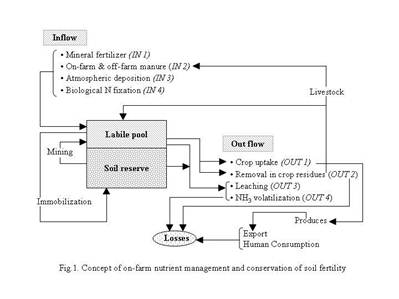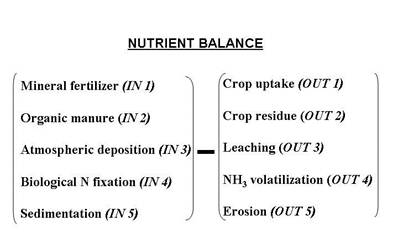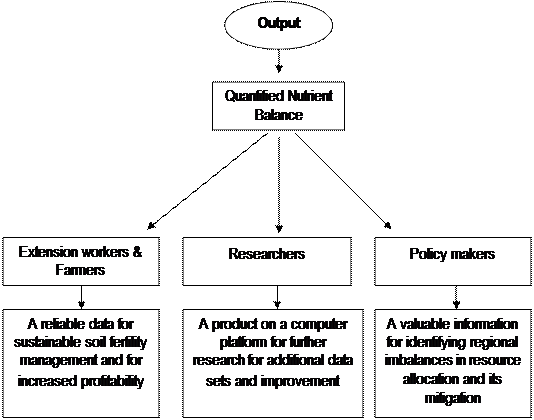|
Monitoring and Optimizing Farm Nutrient Flows And Stocks as the Basis For Integrated Nutrient Management towards Breaking Crop Yield Barrier
Background
The apparent success of production agriculture depends on the exploitation of the world’s capital held in the form of soil organic matter and nutrients. The unintended outcome of production oriented agriculture is recent global degradation of soil and water resources and the consequent loss of biodiversity (Srivastava et al., 1996). Further, high intensive and high yield production system accelerated the mining of soil nutrients by dependence on chemical fertilizers, which failed to maintain the structure and biodiversity essential for long-term production as evident from the imbalanced fertilizer application (NPK use ration in Tamil Nadu 2.3:1.0:1.2 as against 4:2:1).
The policy of attaining higher production without giving due emphasis to sustainability and soil health can be clearly visualized from the declining annual compound yield growth rate (CGR) of 1.31 during 2001 from 2.56 during 1991 in Indian agriculture (Yadav, 2002). For the present level of production the estimated NPK removal is about 28 million tonnes resulting in a net negative nutrient balance of about 10 million tonnes. Organic manures and bio-fertilizers can contribute about 4 million tonnes of nutrients, which means that about 6 million tonnes of negative balance has to be replenished by soil. This is a serious soil health hazard, which needs urgent attention of all concerned.
Nutrient monitoring is a method that quantifies systems' nutrient inflows and outflows, resulting in nutrient balances. Nutrient balances can be determined at spatial scales ranging from national level to field level. A nutrient balance when determined at the level of each individual activity within a farm is a very useful and variable tool providing insight into causes and magnitudes of losses of nutrients from the agricultural production system. This will also enable policy interventions to make corrections in the farming activities.
The approach on nutrient budget and balances have prompted a variety of responses in efforts where conclusions from nutrient budget and balance assessments are increasingly used to justify policies and interventions, at both national and international levels (IFPRI, 1995; FAO, 1996). Nutrient budgets have been used at a variety of levels and for a range of purposes. Papers on quantification and management of on-farm nutrient flows in tropical land use systems have been published in the past years (Mokwunye and Vlek, 1968; Kang and Van der Heide, 1985; Van der Heide, 1989). Most nutrient budgeting studies follow a fairly simple, routine, starting by the identification of the key inputs and outputs in various sub-components of a bounded system (Stoorvogel and Smaling, 1990). Estimation of flows of one or more nutrients (usually N, P and K and ignoring secondary and micronutrients, organic matter status and carbon balances) then follows, either through direct measurement or through literature estimates based on standard functions (for instance, for volatilization, deposition, erosion losses etc.). Budget analyses are thus essentially simple accounting exercises, whereby balances are calculated for each of the identified nutrient 'currencies' through summation.
The NUTMON-Toolbox (Nutrient Monitoring) is a very useful Decision Support System (DSS), which helps to monitor and evaluate the impact of technologies applied by providing scientific and quantitative information (De Jager et al., 1998; Vlaming et al., 1997).
Project rationale
Decline in soil fertility seldom gets the same public attention as floods and droughts, since it is a gradual process and not associated with catastrophes and mass starvation. The change in soil nutrient stocks over time in a given farm has to be measured in order to quantify the extent of nutrient mining and also to provide an early warning on adverse trends in nutrient inflows and outflows from the farm. Hence, a quantitative knowledge on the depletion of plant nutrients from soil is essential to understand the status of soil degradation and to devise optimum nutrient management strategies. Such a quantitative knowledge forms the basis and is essential for any management programme aimed to ensure sustainability in agro-production systems. Restoration of soil fertility can no longer be regarded as an issue connected with the use of organic and inorganic nutrient sources only. It requires a long-term perspective and a holistic approach. The holistic approach should take care of the nutrient stocks within a farm, their flow between various activities within the farm. The nutrient balance at farm level that is arrived by matching nutrient inflows into the farm and nutrient exports out of the farm. Such a knowledge intensive management plan requires participatory research and development focus rather than a purely technical focus. The outcome from this will be useful to agricultural policy makers and also to the farmers to design policy interventions to mitigate undesirable trends, if any in nutrient management.
Project strategy (overall approach):
The cropping intensity in major areas of agro-climatic zones viz., Cauvery Delta zone, Western zone and Southern zones are close to 300 % for annual crops (paddy, maize, pulses etc.) and 100 to 120 % for long duration crops such as sugarcane, turmeric and banana. And it is 30 to 50 % in most of the rainfed regions, where single or no-crop is possible. Thus, there is an excessive depletion of essential nutrients and indiscriminate uses of fertilizers to match the decline in soil fertility are greater environmental concerns.
Nutrient monitoring (NUTMON) is a method that quantifies systems' nutrient inflows and outflows, resulting in nutrient balances (Vlaming et al., 2001). A nutrient balance when determined at the level of each individual activity (crop, livestock etc.) within a farm is a very useful and variable tool providing insight into causes and magnitudes of losses of nutrients from the agricultural production system (figure 1).
The nutrient flow taking place in a crop / cropping system covers all possible inputs and outputs. The inputs (mineral fertilizers, organic manures, atmospheric deposition, biological nitrogen fixation and sedimentation) and outputs (nutrient uptake by economic produce, uptake by crop residue, leaching, NH3 volatilization and erosion loss) will be quantified from farm database, laboratory analysis and by mathematical functions to calculate nutrient balance at different levels viz., crop or cropping system and farm as a whole. The negative trends in nutrient balance and management will be identified for each cropping system and farm to design strategy for farm level nutrient management package for sustainable production.
Project Goals (Objectives)
- To monitor the nutrient stocks and flows and quantify nutrient balance in major crops and cropping systems using Nutrient Monitoring (NUTMON) Tool in Tamil Nadu
- To identify the farm activity or resources, if any, which deplete soil fertility in the farms in different agro-climatic zones of Tamil Nadu
- To formulate policy interventions for on-farm nutrient management and conservation of soil fertility for sustainable agricultural production.
Duration : 2011-2012 (to be extended for 2 more years)
Project components(Programme of work)
The study will be carried out both in high input (irrigated) and low input (rainfed) farming systems of various agro-climatic zones of Tamil Nadu, involving TNAU and Extension functionaries of the Department of Agriculture (DoA). The DoA staff will assist in identifying farms in the study area and in the collection of data on farm and resource inventory. TNAU will carryout the work of farm inventory, collection and analysis of soil, plant and water samples, conducting laboratory experiments, processing, analyses and interpretation of data.
i. Study area
The study will be carried out in major 5 agro-climatic zones of Tamil Nadu viz., North-Eastern, North-Western, Western, Cauvery-Delta and Southern zones. The cropping intensity in major areas of agro-climatic zones viz., Cauvery Delta zone, Western zone and Southern zones are close to 300 % for annual crops (paddy, maize, pulses etc.) and 100 to 120 % for long duration crops such as sugarcane, turmeric and banana. And it is 30 to 50 % in most of the rainfed regions, where single or no-crop is possible. On an average 10 farms in each of 5 agro-climatic zones involving the major cropping systems, input levels and organic farming practices will be studied.
ii. Major Crop / cropping system to be studied
| High Input System (Irrigated) |
Low Input System (Rainfed) |
Rice – rice - pulses
Rice – sugarcane
Turmeric – sugarcane
Turmeric - banana
Sugarcane – oilseeds
Cotton-oilseeds
Sugarcane, Maize, tapioca and banana as single crop |
Groundnut + redgram
Sorghum + pulses
Sorghum alone
Groundnut alone
Cotton alone
Tapioca alone
Maize alone |
iii. Technical programme
A decision support system for nutrient monitoring under agricultural land use viz., NUTMON-Toolbox is to be employed to monitor the effects of changing land use on nutrient balance. NUTMON-Toolbox is user friendly computerized software for monitoring nutrient flows and stock especially in tropical soils (Vlaming et al., 2001). This product consist of structured questionnaire, a database, and two simple static models (NUTCAL for calculation of nutrient flows and ECCAL for calculation of economic parameters). Finally, a user-interface facilitates data entry and data processing. The tool calculates flows and balances of the macronutrients (N, P and K) of the farm through independent assessment of major inputs and outputs using the following equation.
Net soil nutrient balance = S (Nutrient INPUTS ) - S ( Nutrient OUTPUTS )
The study will be carried out on a farmers’ participatory approach. The resource inventory will be carried out to generate basic information and the periodical monitoring will be done to quantify the nutrient flows in the farm.
iii-a. Resource Inventory
- The major units and all possible nutrient flows in the farm will be identified by means of interviews with the farmer and field measurements. Soil sampling and laboratory measurements will be done at the beginning of each monitoring period. This will be carried out at the beginning of the crop growing season
iii-b. Monitoring nutrient flows
- The purpose of farm monitoring is to describe the actual farm management and is recorded as a set of flows of materials (crop products, manure, fertilizer, etc,) between units within the farm (internal flows) and between farm units and external world.
- The framework of farm unit setup during the inventory is used as a reference for the sources and destinations of all the flows and will be done at regular intervals.
- Monitoring will be carried out at monthly interval in the selected farms
iii-c. Analysis
Data will be analyzed with NUTMON-Toolbox to;
- quantify and characterize the production factors available on the farm i.e., overview and characteristics of land size, livestock, soils, climate, etc.,
- analyze the activities and location of the production factors with regard to soil fertility i.e., crop yield, nutrient balance per crop and for the entire farm, flows between the activities (viz., crop, animal, household, external etc.), fertilizer use, crop-livestock reactions, nutrient sinks and sources.
Methods to quantify flows
Three methods are used to quantify the nutrient flows: (1) asking the farmer, (2) use of transfer functions, (3) additional observations
Method 1: Asking the farmer
This method combines information from the questionnaire (quantities and directions of the flows of products) with information from the Background Database (e.g. nutrient contents of the various materials), which is available in the NUTMON-Toolbox itself. All nutrient flows related to import of farm inputs and export of farm products (classified as IN 1, IN 2, OUT1 and OUT 2) will be quantified according to this method and the factors will be suitably modified wherever necessary.
Method 2: Use of transfer functions
Transfer functions are used to estimate those nutrient flows for which the information cannot be provided by the farmer or obtained by simple measurements. They are used to estimate wet and dry atmospheric deposition (IN 3), biological N fixation (IN 4), deposition (IN 5), leaching from soils (OUT 3), gaseous losses from soils (OUT 4) and erosion (OUT 5). Transfer functions are simple relations that quantify difficult-to-quantify variables as a function of easily obtainable parameters, such as mean annual precipitation and clay content of the soil.
- For wet and dry deposition (IN 3), the inbuilt transfer functions in NUTMON-Toolbox as described by Smaling et al. (1993) will be used where nutrient input was considered as a function of square root of average rainfall in mm/yr.
- A small rainfall dependent contribution from non-symbiotic fixers to calculate IN 4 will be accounted as per the procedure of Stoorvogel and Smaling (1990). The relative contribution of symbiotic and associative N fixation to that of free-living organisms to the global total was taken as 70: 30 as assessed by Paul (1988).
- Nitrogen contribution from groundwater (IN 5) was considered negligible in tropical conditions (Kroeze et al., 2003) and therefore only P and K inputs from sedimentation is accounted in IN 5 based on the results of Abedin et al. (1991) and Handa (1988) who, respectively, calculated 1.5 kg P yr-1 and 10 kg K yr-1 as inputs from sediments.
- The point data on leaching (OUT 3) and denitrification (OUT 4) will be worked out by utilizing the inbuilt transfer functions in NUTMON-Toolbox and using the available data on rainfall, texture, soil N and K content and fertilizer input (Smaling et al., 1993).
- The mineralization rate to calculate OUT 3 will be based on Tisdale et al., 1985.
Method 3: Additional observations
This procedure is intended to gather additional information that is needed for the calculations but that cannot be given by the farmer, for instance nutrient contents of crop products and fertilizers, soil parameters, and calibration factors for local units of measurement. This information will be gathered from literature reviews that provide data valid for the study area.
Deliverables (supply of inputs / equipments etc to farmers) : NIL
Measurable outcome
Utility of the product
- The Nutrient Monitoring helps in regular monitoring of farm level nutrient budgets
- The output provides management interventions to mitigate negative nutrient budgets
-
It enables optimization of resource allocation at farm level, as it indicate the quantity and direction of flow of nutrients which takes place between different farm components viz., different crops, manure source, animals, household and external etc. (Figure 2).
-
bove all the output presents an improved alternative to the present approach and technology of Integrated Nutrient Management for breaking crop yield barrier.
Figure 2. NUTMON-Toolbox generated flow diagram showing the flows between various units within a farm
Contact:
Director,
Directorate of Natural Resource Management
Tamil Nadu Agricultural University
Coimbatore 641003
Phone: 0422-6611390
Fax: 0422-6611405
E-mail: nrm@tnau.ac.in |




